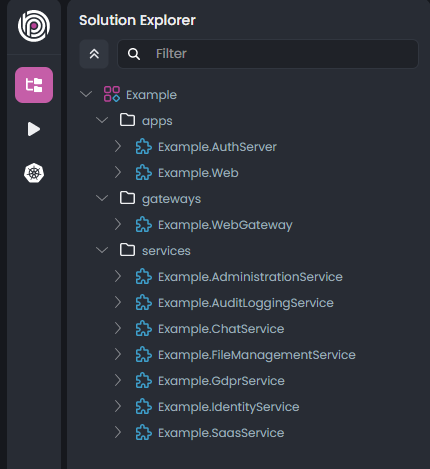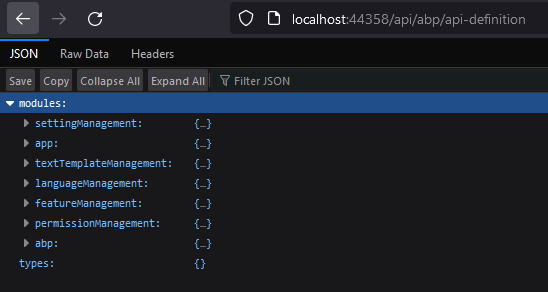Activities of "hiltond"
Following the steps above when I try to generate the proxy I get:
 It gives the same result for a JS version as well.
It gives the same result for a JS version as well.
I had the same result with my real project I am developing also.
To try a few extra things I also ran it with the module name as Example.MyService to no avail.
I also tried to generate the proxy directly in the MyService project instead of Web. (Assuming this is wrong generally, but I tried it nonetheless)
Running against the service directly without specifying the Module gave this error (Also guessing this is unimportant here and the running vs Web is what matters?) I also ran it from the Web directory and it gave the same basic error about not finding the file.
PS C:\Source\Example\Example\apps\web\Example.Web> abp generate-proxy -t csharp --url http://localhost:44315 --without-contracts
ABP CLI 8.1.1
Could not find a part of the path 'C:\Source\Example\Example\apps\web\Example.Web\ClientProxies\app-generate-proxy.json'.
System.IO.DirectoryNotFoundException: Could not find a part of the path 'C:\Source\Example\Example\apps\web\Example.Web\ClientProxies\app-generate-proxy.json'.
at Microsoft.Win32.SafeHandles.SafeFileHandle.CreateFile(String fullPath, FileMode mode, FileAccess access, FileShare share, FileOptions options)
at Microsoft.Win32.SafeHandles.SafeFileHandle.Open(String fullPath, FileMode mode, FileAccess access, FileShare share, FileOptions options, Int64 preallocationSize, Nullable`1 unixCreateMode)
at System.IO.Strategies.OSFileStreamStrategy..ctor(String path, FileMode mode, FileAccess access, FileShare share, FileOptions options, Int64 preallocationSize, Nullable`1 unixCreateMode)
at System.IO.Strategies.FileStreamHelpers.ChooseStrategyCore(String path, FileMode mode, FileAccess access, FileShare share, FileOptions options, Int64 preallocationSize, Nullable`1 unixCreateMode)
at System.IO.StreamWriter.ValidateArgsAndOpenPath(String path, Boolean append, Encoding encoding, Int32 bufferSize)
at System.IO.StreamWriter..ctor(String path)
at Volo.Abp.Cli.ServiceProxying.CSharp.CSharpServiceProxyGenerator.CreateJsonFile(GenerateProxyArgs args, ApplicationApiDescriptionModel applicationApiDescriptionModel) in D:\ci\Jenkins\workspace\abp-volo-release\abp\framework\src\Volo.Abp.Cli.Core\Volo\Abp\Cli\ServiceProxying\CSharp\CSharpServiceProxyGenerator.cs:line 166
at Volo.Abp.Cli.ServiceProxying.CSharp.CSharpServiceProxyGenerator.GenerateProxyAsync(GenerateProxyArgs args) in D:\ci\Jenkins\workspace\abp-volo-release\abp\framework\src\Volo.Abp.Cli.Core\Volo\Abp\Cli\ServiceProxying\CSharp\CSharpServiceProxyGenerator.cs:line 154
at Volo.Abp.Cli.Commands.ProxyCommandBase`1.ExecuteAsync(CommandLineArgs commandLineArgs) in D:\ci\Jenkins\workspace\abp-volo-release\abp\framework\src\Volo.Abp.Cli.Core\Volo\Abp\Cli\Commands\ProxyCommandBase.cs:line 57
at Volo.Abp.Cli.CliService.RunInternalAsync(CommandLineArgs commandLineArgs) in D:\ci\Jenkins\workspace\abp-volo-release\abp\framework\src\Volo.Abp.Cli.Core\Volo\Abp\Cli\CliService.cs:line 173
at Volo.Abp.Cli.CliService.RunAsync(String[] args) in D:\ci\Jenkins\workspace\abp-volo-release\abp\framework\src\Volo.Abp.Cli.Core\Volo\Abp\Cli\CliService.cs:line 80
Unhandled exception. System.IO.DirectoryNotFoundException: Could not find a part of the path 'C:\Source\Example\Example\apps\web\Example.Web\ClientProxies\app-generate-proxy.json'.
at Microsoft.Win32.SafeHandles.SafeFileHandle.CreateFile(String fullPath, FileMode mode, FileAccess access, FileShare share, FileOptions options)
at Microsoft.Win32.SafeHandles.SafeFileHandle.Open(String fullPath, FileMode mode, FileAccess access, FileShare share, FileOptions options, Int64 preallocationSize, Nullable`1 unixCreateMode)
at System.IO.Strategies.OSFileStreamStrategy..ctor(String path, FileMode mode, FileAccess access, FileShare share, FileOptions options, Int64 preallocationSize, Nullable`1 unixCreateMode)
at System.IO.Strategies.FileStreamHelpers.ChooseStrategyCore(String path, FileMode mode, FileAccess access, FileShare share, FileOptions options, Int64 preallocationSize, Nullable`1 unixCreateMode)
at System.IO.StreamWriter.ValidateArgsAndOpenPath(String path, Boolean append, Encoding encoding, Int32 bufferSize)
at System.IO.StreamWriter..ctor(String path)
at Volo.Abp.Cli.ServiceProxying.CSharp.CSharpServiceProxyGenerator.CreateJsonFile(GenerateProxyArgs args, ApplicationApiDescriptionModel applicationApiDescriptionModel) in D:\ci\Jenkins\workspace\abp-volo-release\abp\framework\src\Volo.Abp.Cli.Core\Volo\Abp\Cli\ServiceProxying\CSharp\CSharpServiceProxyGenerator.cs:line 166
at Volo.Abp.Cli.ServiceProxying.CSharp.CSharpServiceProxyGenerator.GenerateProxyAsync(GenerateProxyArgs args) in D:\ci\Jenkins\workspace\abp-volo-release\abp\framework\src\Volo.Abp.Cli.Core\Volo\Abp\Cli\ServiceProxying\CSharp\CSharpServiceProxyGenerator.cs:line 154
at Volo.Abp.Cli.Commands.ProxyCommandBase`1.ExecuteAsync(CommandLineArgs commandLineArgs) in D:\ci\Jenkins\workspace\abp-volo-release\abp\framework\src\Volo.Abp.Cli.Core\Volo\Abp\Cli\Commands\ProxyCommandBase.cs:line 57
at Volo.Abp.Cli.CliService.RunInternalAsync(CommandLineArgs commandLineArgs) in D:\ci\Jenkins\workspace\abp-volo-release\abp\framework\src\Volo.Abp.Cli.Core\Volo\Abp\Cli\CliService.cs:line 173
at Volo.Abp.Cli.CliService.RunAsync(String[] args) in D:\ci\Jenkins\workspace\abp-volo-release\abp\framework\src\Volo.Abp.Cli.Core\Volo\Abp\Cli\CliService.cs:line 80
at Volo.Abp.Cli.Program.Main(String[] args) in D:\ci\Jenkins\workspace\abp-volo-release\abp\framework\src\Volo.Abp.Cli\Volo\Abp\Cli\Program.cs:line 43
at Volo.Abp.Cli.Program.<Main>(String[] args)
Hello,
I am working on developing with the ABP Studio microservice template and have a few questions on expected setup for new microservices. I have generated a basic setup using the microservice template (EF Core, MVC, no mobile UI).
 I follow the add new microservice (EF Core) option here:
I follow the add new microservice (EF Core) option here:
 I get this initial layout:
I get this initial layout:

It doesn’t seem like these microservice templates have proxy support by default (C# or JS). I would like to add this functionality in but have been struggling with how it should be added and what is required for full functionality.
I suspect that we would want to add some dependencies or setup code to the MyServiceModule and MyServiceContractsModule that mimics the HttpApi and HttpApi.Client from the DDD services in the past. I couldn’t glean any information from the other services because they seem to rely on full DDD components through library references.
I was able to generate a static JS proxy but could not understand the correct auth flow it required to work against an authorized endpoint. I could not get the C# proxies to properly generate at all (static or dynamic.)
A few things I would like clarified:
- What is the minimum implementation to enable proxies (C#, JS, static and dynamic) in the new microservice service template? (I would like to avoid using more project layers than what already exists, this defeats the purpose of using the simpler service template) - What is required for the Web project to use both the C# proxy through MVC razor and the JS proxy through a web page directly? - Is anything required for the gateway? - What is required for proper auth flows using both proxies?
Thanks!
- ABP Framework version: v8.1.1
- UI Type: MVC
- Database System: EF Core (SQL Server)
- Tiered (for MVC) or Auth Server Separated (for Angular): Studio Microservice Template
Having an Issue loading a new ABP solution created in Studio version 0.6.2.0
I follow the New Solution wizard with these options: Microservice Template Solution Name: Test Output Folder: Empty Folder Create Solution folder checked EF Core SQLServer MVC No Mobile UI All Optional Modules LeptonX
Then upon loading the solution I get this error in the logs in ABP Studio: Error Failed to load tree item "Volo.Abp.Studio.UI.Solutions.Items.SolutionUIModel"
This happens every time I try to load the solution, even after restarting the application. I also did a fresh installation of Studio and had the same issue.
The Authority endpoint in the Module project was wrong, I fixed that and now I get this error on request:
2020-05-19 08:50:39.673 -05:00 [INF] Request starting HTTP/1.1 GET https://localhost:44321/api/devices?serialNumber=string&api-version=1.0
2020-05-19 08:50:40.147 -05:00 [INF] Failed to validate the token.
Microsoft.IdentityModel.Tokens.SecurityTokenInvalidAudienceException: IDX10214: Audience validation failed. Audiences: 'Portal'. Did not match: validationParameters.ValidAudience: 'Devices' or validationParameters.ValidAudiences: 'null'.
at Microsoft.IdentityModel.Tokens.Validators.ValidateAudience(IEnumerable`1 audiences, SecurityToken securityToken, TokenValidationParameters validationParameters)
at System.IdentityModel.Tokens.Jwt.JwtSecurityTokenHandler.ValidateAudience(IEnumerable`1 audiences, JwtSecurityToken jwtToken, TokenValidationParameters validationParameters)
at System.IdentityModel.Tokens.Jwt.JwtSecurityTokenHandler.ValidateTokenPayload(JwtSecurityToken jwtToken, TokenValidationParameters validationParameters)
at System.IdentityModel.Tokens.Jwt.JwtSecurityTokenHandler.ValidateToken(String token, TokenValidationParameters validationParameters, SecurityToken& validatedToken)
at Microsoft.AspNetCore.Authentication.JwtBearer.JwtBearerHandler.HandleAuthenticateAsync()
2020-05-19 08:50:40.169 -05:00 [INF] BearerIdentityServerAuthenticationJwt was not authenticated. Failure message: IDX10214: Audience validation failed. Audiences: 'Portal'. Did not match: validationParameters.ValidAudience: 'Devices' or validationParameters.ValidAudiences: 'null'.
2020-05-19 08:50:40.170 -05:00 [INF] Bearer was not authenticated. Failure message: IDX10214: Audience validation failed. Audiences: 'Portal'. Did not match: validationParameters.ValidAudience: 'Devices' or validationParameters.ValidAudiences: 'null'.
2020-05-19 08:50:40.176 -05:00 [INF] Authorization failed.
2020-05-19 08:50:40.181 -05:00 [INF] AuthenticationScheme: BearerIdentityServerAuthenticationJwt was challenged.
2020-05-19 08:50:40.181 -05:00 [INF] AuthenticationScheme: Bearer was challenged.
2020-05-19 08:50:40.182 -05:00 [INF] Request finished in 508.9196ms 401
I'm guessing I am missing some part of the configuration in the Identity Server but I'm not sure what.
That fixed the permission issue. Now when I try the request from the Web project to the Remote API through the "Devices" page that I made before I get these errors in the logs for the Remote API service:
2020-05-18 09:58:34.520 -05:00 [INF] Request finished in 125.7825ms 200 application/json;charset=utf-8
2020-05-18 09:58:35.684 -05:00 [INF] Request starting HTTP/1.1 GET https://localhost:44321/api/devices?serialNumber=string&api-version=1.0
2020-05-18 09:58:39.874 -05:00 [ERR] Exception occurred while processing message.
System.InvalidOperationException: IDX20803: Unable to obtain configuration from: 'https://localhost:44349/.well-known/openid-configuration'.
---> System.IO.IOException: IDX20804: Unable to retrieve document from: 'https://localhost:44349/.well-known/openid-configuration'.
---> System.Net.Http.HttpRequestException: No connection could be made because the target machine actively refused it.
---> System.Net.Sockets.SocketException (10061): No connection could be made because the target machine actively refused it.
at System.Net.Http.ConnectHelper.ConnectAsync(String host, Int32 port, CancellationToken cancellationToken)
--- End of inner exception stack trace ---
at System.Net.Http.ConnectHelper.ConnectAsync(String host, Int32 port, CancellationToken cancellationToken)
at System.Net.Http.HttpConnectionPool.ConnectAsync(HttpRequestMessage request, Boolean allowHttp2, CancellationToken cancellationToken)
at System.Net.Http.HttpConnectionPool.CreateHttp11ConnectionAsync(HttpRequestMessage request, CancellationToken cancellationToken)
at System.Net.Http.HttpConnectionPool.GetHttpConnectionAsync(HttpRequestMessage request, CancellationToken cancellationToken)
at System.Net.Http.HttpConnectionPool.SendWithRetryAsync(HttpRequestMessage request, Boolean doRequestAuth, CancellationToken cancellationToken)
at System.Net.Http.RedirectHandler.SendAsync(HttpRequestMessage request, CancellationToken cancellationToken)
at System.Net.Http.DiagnosticsHandler.SendAsync(HttpRequestMessage request, CancellationToken cancellationToken)
at System.Net.Http.HttpClient.FinishSendAsyncBuffered(Task`1 sendTask, HttpRequestMessage request, CancellationTokenSource cts, Boolean disposeCts)
at Microsoft.IdentityModel.Protocols.HttpDocumentRetriever.GetDocumentAsync(String address, CancellationToken cancel)
--- End of inner exception stack trace ---
at Microsoft.IdentityModel.Protocols.HttpDocumentRetriever.GetDocumentAsync(String address, CancellationToken cancel)
at Microsoft.IdentityModel.Protocols.OpenIdConnect.OpenIdConnectConfigurationRetriever.GetAsync(String address, IDocumentRetriever retriever, CancellationToken cancel)
at Microsoft.IdentityModel.Protocols.ConfigurationManager`1.GetConfigurationAsync(CancellationToken cancel)
--- End of inner exception stack trace ---
at Microsoft.IdentityModel.Protocols.ConfigurationManager`1.GetConfigurationAsync(CancellationToken cancel)
at Microsoft.AspNetCore.Authentication.JwtBearer.JwtBearerHandler.HandleAuthenticateAsync()
2020-05-18 09:58:39.898 -05:00 [ERR] IDX20803: Unable to obtain configuration from: 'https://localhost:44349/.well-known/openid-configuration'.
System.InvalidOperationException: IDX20803: Unable to obtain configuration from: 'https://localhost:44349/.well-known/openid-configuration'.
---> System.IO.IOException: IDX20804: Unable to retrieve document from: 'https://localhost:44349/.well-known/openid-configuration'.
---> System.Net.Http.HttpRequestException: No connection could be made because the target machine actively refused it.
---> System.Net.Sockets.SocketException (10061): No connection could be made because the target machine actively refused it.
at System.Net.Http.ConnectHelper.ConnectAsync(String host, Int32 port, CancellationToken cancellationToken)
--- End of inner exception stack trace ---
at System.Net.Http.ConnectHelper.ConnectAsync(String host, Int32 port, CancellationToken cancellationToken)
at System.Net.Http.HttpConnectionPool.ConnectAsync(HttpRequestMessage request, Boolean allowHttp2, CancellationToken cancellationToken)
at System.Net.Http.HttpConnectionPool.CreateHttp11ConnectionAsync(HttpRequestMessage request, CancellationToken cancellationToken)
at System.Net.Http.HttpConnectionPool.GetHttpConnectionAsync(HttpRequestMessage request, CancellationToken cancellationToken)
at System.Net.Http.HttpConnectionPool.SendWithRetryAsync(HttpRequestMessage request, Boolean doRequestAuth, CancellationToken cancellationToken)
at System.Net.Http.RedirectHandler.SendAsync(HttpRequestMessage request, CancellationToken cancellationToken)
at System.Net.Http.DiagnosticsHandler.SendAsync(HttpRequestMessage request, CancellationToken cancellationToken)
at System.Net.Http.HttpClient.FinishSendAsyncBuffered(Task`1 sendTask, HttpRequestMessage request, CancellationTokenSource cts, Boolean disposeCts)
at Microsoft.IdentityModel.Protocols.HttpDocumentRetriever.GetDocumentAsync(String address, CancellationToken cancel)
--- End of inner exception stack trace ---
at Microsoft.IdentityModel.Protocols.HttpDocumentRetriever.GetDocumentAsync(String address, CancellationToken cancel)
at Microsoft.IdentityModel.Protocols.OpenIdConnect.OpenIdConnectConfigurationRetriever.GetAsync(String address, IDocumentRetriever retriever, CancellationToken cancel)
at Microsoft.IdentityModel.Protocols.ConfigurationManager`1.GetConfigurationAsync(CancellationToken cancel)
--- End of inner exception stack trace ---
at Microsoft.IdentityModel.Protocols.ConfigurationManager`1.GetConfigurationAsync(CancellationToken cancel)
at Microsoft.AspNetCore.Authentication.JwtBearer.JwtBearerHandler.HandleAuthenticateAsync()
at Microsoft.AspNetCore.Authentication.JwtBearer.JwtBearerHandler.HandleAuthenticateAsync()
at Microsoft.AspNetCore.Authentication.AuthenticationHandler`1.AuthenticateAsync()
at Microsoft.AspNetCore.Authentication.AuthenticationService.AuthenticateAsync(HttpContext context, String scheme)
at IdentityServer4.AccessTokenValidation.IdentityServerAuthenticationHandler.HandleAuthenticateAsync()
2020-05-18 09:58:39.900 -05:00 [INF] Bearer was not authenticated. Failure message: IDX20803: Unable to obtain configuration from: 'https://localhost:44349/.well-known/openid-configuration'.
2020-05-18 09:58:39.907 -05:00 [INF] Authorization failed.
2020-05-18 09:58:39.914 -05:00 [INF] AuthenticationScheme: BearerIdentityServerAuthenticationJwt was challenged.
2020-05-18 09:58:39.914 -05:00 [INF] AuthenticationScheme: Bearer was challenged.
2020-05-18 09:58:39.916 -05:00 [INF] Request finished in 4231.9708ms 401
In the Remote API solution (which is a module template solution) in Application.Contracts I have two files in an Authorization folder: DevicesPermissionDefinitionProvider
using Volo.Abp.Authorization.Permissions;
using Volo.Abp.Localization;
namespace NowMicro.Dice.Devices.Authorization
{
public class DevicesPermissionDefinitionProvider : PermissionDefinitionProvider
{
public override void Define(IPermissionDefinitionContext context)
{
var devicesGroup = context.AddGroup(DevicesPermissions.GroupName);
var products = devicesGroup.AddPermission(DevicesPermissions.Devices.Default);
products.AddChild(DevicesPermissions.Devices.Update);
products.AddChild(DevicesPermissions.Devices.Delete);
products.AddChild(DevicesPermissions.Devices.Create);
}
}
}
DevicesPermissions
using Volo.Abp.Reflection;
namespace NowMicro.Dice.Devices.Authorization
{
public class DevicesPermissions
{
public const string GroupName = "Devices";
public static class Devices
{
public const string Default = GroupName + ".Device";
public const string Delete = Default + ".Delete";
public const string Update = Default + ".Update";
public const string Create = Default + ".Create";
}
public static string[] GetAll()
{
return ReflectionHelper.GetPublicConstantsRecursively(typeof(DevicesPermissions));
}
}
}
As suggested earlier, I created a tiered version of the web project: MVC, no mobile, EF Core, and tiered. Steps I took after that:
- I ran the db migrator against a fresh database.
- Commented out redis config stuff in the host modules that use it because I don't have a local redis cache.
//context.Services.AddStackExchangeRedisCache(options =>
//{
// options.Configuration = configuration["Redis:Configuration"];
//});
- I added the Devices page in the web project to reference the remote API in the same way as my initial post. This included referencing the same assemblies and adding
typeof(DevicesHttpApiClientModule), typeof(AbpHttpClientIdentityModelModule)as dependency references in the WebModule.cs file. - I ran the sites and went into the User Management to give permissions for the remote API permission set like I did in the non-tiered project, but I don't see the permission set in there, it seems to be missing and I'm not sure why. Is there some other place I need to add a reference or something in the tiered web project that I didn't have to in the non-tiered one to show these permissions?
I've setup a tiered version of the web project, but I'm running into a problem getting the permissions for the remote API to show up. When I go to add the permissions to the admin user I don't see any for the remote API permission set I created. I have references for typeof(DevicesHttpApiClientModule), typeof(AbpHttpClientIdentityModelModule) in the Web module. Am I missing something in the tiered version that wasn't required in the non-tiered one?


